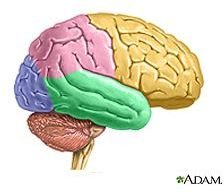Teaching Students With Traumatic Brain Injury and Memory Loss
Traumatic brain injury (TBI), which the Merck Manual Professional Edition defines as a “physical injury to [the] brain tissue that
temporarily or permanently impairs brain function,” can pose a problem in the classroom. Besides the 65 and older population, children up to the age of 4 and adolescents between ages 15 and 19 are the most likely to suffer from a TBI, according to the Centers for Disease Control and Prevention (CDC). Even in cases of mild TBI, the patient can have problems with memory and attention. Part of the treatment for TBI is neuropsychological rehabilitation, which can be used in the classroom as well.
Memory and Attention Strategies for TBI
The American Brain Tumor Association states that a student can be taught different cognitive strategies, which can help her overcome any difficulties that begin after the injury. Since some of the deficits that can arise in TBI resemble other disabilities, like attention deficit hyperactivity disorder (ADHD), teachers may recognize some of the strategies.
Brain injury memory loss can be a problem, so teachers may need to work with the students on creating a better way to learn. For example, the student may need to work on note taking. The American Brain Tumor Association recommends teaching the child to take notes containing the full information, using the “who, what, where, why and how” questions when writing. Because the student can have a harder time retaining information after the injury, the teacher should allow her to refer to her notes regularly. Integrating other senses when studying can also help the student remember. One way is visualization. To practice this technique, read the student a list of words, having her picture them one at a time in a room. After finishing the list, have her write the words she remembered down.
Organization is also an important technique to go over with the student, as she may have more difficulty after the injury. Suggest a daily planner, in which she can write everything she needs to do down. To help with inattention, the student can make a checklist to record what she has to do, and when she gets them done. Reduce distractions, and also have the student double-check all of her work. Self-talking techniques can also help the child maintain focus and redirect herself. Encourage the student to maintain eye contact when listening to a speaker, as this can help her sustain her attention, according to the American Brain Tumor Association.
Exercises for the Classroom
Certain exercises used in neuropsychological rehabilitation can be introduced into the classroom, and further help with the student’s cognitive functions. The American Brain Tumor Association recommends using computer programs, which exercise visual-perceptual skills, reaction time, memory and attention. One option is the Towers of Hanoi, in which the student must stack disks in a certain order. While this test can be done manually, the computerized version can monitor and track the student’s progress. Other activities that integrate multiple cognitive functions, like workbooks, puzzle books and strategic games, can also help improve memory and other functions in a TBI patient.
References
- American Brain Tumor Association: Cognitive Retraining
- Merck Manual Professional Edition: Traumatic Brain Injury (TBI), by James Wilberger
- CDC: How Many People Have TBI?
This post is part of the series: How the Brain Works
Informational articles about brain and how it relates to special education arenas.
